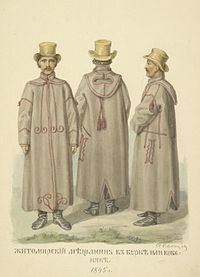Kobeniak
Currently, Kobeniak has become a topic of great relevance and interest for a wide spectrum of society. People increasingly seek to understand and explore the different facets and applications of Kobeniak, whether in the professional, academic or personal sphere. This topic has been positioned as a central point of discussion and debate in various areas, generating deep reflections and analyzes on its impact and relevance in modern life. Kobeniak has sparked a large number of research, projects and cultural productions that seek to understand and apply its concepts in an innovative and creative way. In this article, we will explore the multiple dimensions and perspectives that Kobeniak offers, as well as its importance in the current context.


Kobeniak (Кобеняк) is a Ukrainian traditional male outer garment. Similar terms are Hungarian köpönyeg for "cloak", "mantle", "overcoat", and a historical Polish garment, kopieniak, all terms being derived from the Turkish garment kepenek, which is a shepherd's garment. Kobeniak is also called burka (cf. "Burka (Caucasus)"), kireya, or siryak (бурка, кирея, сіряк).
A kobenyak was the widest garment, so that it could be worn even on top of a kozhukh (fur coat). A distinctive feature is a hood which could cover nearly all the face, with a cut for the eyes and possibly for the mouth, which may be folded back.
References
- ^ "Encyklopedia staropolska/Kopieniak - Wikiźródła, teksty i materiały źródłowe" (in Polish). Pl.wikisource.org. 2014-02-06. Retrieved 2014-02-17.
- ^ a b Вовк, Хведір. "Студії з української етнографії та антропології", Прага : Укр. громад. вид. фонд, (Publ. «Легіографія»). — 354pp.